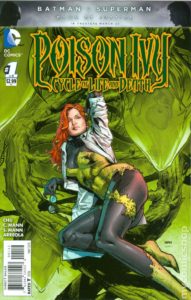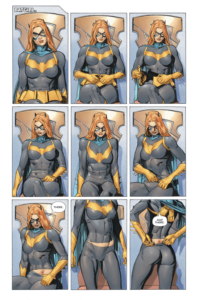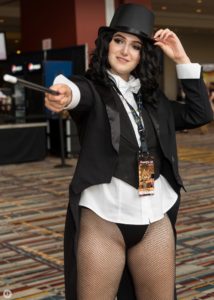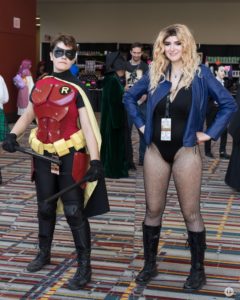On April 1st, my class The Art of Steve Prince had a guest Professor, Mark Broomfield who teaches dancing. Although he did teach us all how to dance, his primary lesson focused on how we as a society apply gender roles to movements and poses. He separated us into groups and had us come up with two dance moves; a feminine one and a masculine one. We performed our collective moves and he then asked us what made our moves feminine and masculine. He talked about how we assign these gender roles to body movements, but ultimately they are just movement that anyone can make regardless of what gender they identify with. He then asked us to counteract our original gender assignments to the dance moves. Each group came up with different solutions-mine perform both moves at the same time to make them appear unisex.
During the exercise, I was reminded of my experience in the world of cosplay, as a comic book fan. It is probably already a bit obvious even to those who don’t read comics, but women are extremely sexualized and objectified in the comic book industry. Throughout comic book history, female superheroes are often either drawn in positions of vulnerability on cover art, or are meant to be striking a powerful pose, but the attention is drawn to their boobs and butts, negating their power. This isn’t an ancient practice either, as recent as this year a comic run “Heroes in Crisis,” from DC came out with a panel in which Batgirl is showing a scar on her lower back. Except, the scar isn’t the primary focus of the illustration, her butt is.


Many have argued that male characters are just as sexualized but the argument is simply ridiculous. Male characters are drawn to look attractive yes, but when Batman is captured by the Joker, we don’t get cover art of him in a cage crying, facing ass up. We get cover art of him looking angry, in chains. Male characters are never drawn in positions that make them look inherently weak, but women are generally either drawn to look weak or drawn to look sexy, or both at the same time.

As bleak as the comic book industry is, there is a silver lining. The extreme exploitation of women within the industry does not often carry over to the world of cosplay. I was reminded in class of the poses I use when being photographed. Many are not necessarily unfeminine, but they are all meant to make my character look powerful. The picture above is my go-to pose for Zatanna, a magician hero, me casting a spell.
 There is of course the famous Wonder Woman pose, which is a staple in any female cosplayer’s lineup. It is a stance that radiates power, shoulders back, fists on hips, legs apart. There is a considerable amount of push back on gender stereotypes within the cosplay community and I hope as time goes on, the world of comic books will improve as well.
There is of course the famous Wonder Woman pose, which is a staple in any female cosplayer’s lineup. It is a stance that radiates power, shoulders back, fists on hips, legs apart. There is a considerable amount of push back on gender stereotypes within the cosplay community and I hope as time goes on, the world of comic books will improve as well.
In class that day, I really saw the both/and when looking at the gendered body movements in dancing, and cosplay. I really appreciated that we all tried to defy and push back against these made up roles, and I really appreciate Professor Broomfield for teaching us. Dancing is such a joyous act and it was great to find a way to address things like gender roles through something that still brought happiness to everyone.




 There is of course the famous Wonder Woman pose, which is a staple in any female cosplayer’s lineup. It is a stance that radiates power, shoulders back, fists on hips, legs apart. There is a considerable amount of push back on gender stereotypes within the cosplay community and I hope as time goes on, the world of comic books will improve as well.
There is of course the famous Wonder Woman pose, which is a staple in any female cosplayer’s lineup. It is a stance that radiates power, shoulders back, fists on hips, legs apart. There is a considerable amount of push back on gender stereotypes within the cosplay community and I hope as time goes on, the world of comic books will improve as well.